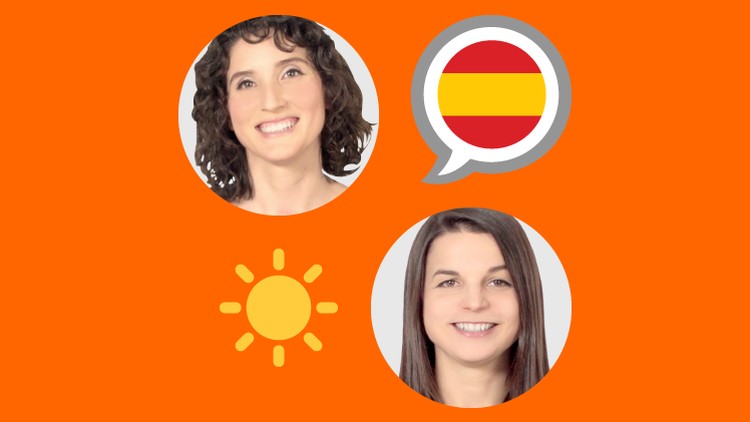Learn Spanish for Beginners: The Ultimate 80-Lesson Course
- Description
- Curriculum
- FAQ
- Reviews

Are you ready to start speaking, writing and understanding Spanish in minutes? Then, this is the course for you. You unlock 80 high-quality beginner video lessons and we’ll guide you step-by-step.
Learn Spanish with lessons made by real teachers.
In every lesson, we take you by the hand and guide you through the language.
You will…
- Learn How to Read and Write Spanish
- Sound like a Native Speaker with Pronunciation Lessons
- Learn Basic Spanish Conversation Skills with the 3-Minute Video Series
- Sharpen Your Listening with Comprehension Lessons
- Get Access to 80 High-Definition Video Lessons
- Unlock Bonus Access to Lesson Transcripts and Vocabulary Lists
This is the ultimate starting point for any beginner.
By the end, you’ll be able to hold basic Spanish conversations – such as introducing yourself, asking for directions and making small talk with others. You’ll also know how to read and write in Spanish.
If you’re a beginner and want to learn Spanish in the fastest, easiest and most fun way, start here. This course is broken up into 5 parts:
- Introduction to Spanish: Want to learn Spanish? Don’t know where to start? This is it. The Introduction to Spanish Video series is perfect for those who know zero Spanish but want to take that first step. In this 5-lesson series, you’ll learn all about the Spanish language, as well as grammar, writing and phrases to get you started.
- Ultimate Spanish Pronunciation Guide: Ready to sound like a native Spanish speaker? Join Alisha and Alex in the Ultimate Mexican Spanish Pronunciation Series! In these 25 video lessons, you’ll learn the ins and outs of perfect Spanish pronunciation. You’ll learn the common mistakes learners make, how to avoid them, and the nuances that only native speakers are aware of.
- Learn Spanish in Three Minutes: In any Spanish speaking country, manners are important, and in this 25-lesson series, you’ll learn some of the basics you need to be polite while speaking Spanish. Lucia will take you step-by-step through must-know phrases like “Do you speak English?” and “Hello, my name is…”. See the phrases broken down on screen while native Spanish speaker Lucia explains the grammar and composition. Plus, you’ll get some special tips on how to be extra authentic when interacting with native Spanish speakers. The best part? You’ll do all this in just 3 quick minutes.
- Spanish Listening Comprehension for Absolute Beginners: Improve your Spanish listening skills in every lesson! This Spanish Listening Comprehension Series tests you on your listening and makes sure you understand every word. Listen to the dialog, watch the video, and answer the questions asked. This video series is perfect for Absolute Beginners.
- Spanish Listening Comprehension for Beginners: Ready to understand even more Spanish? This Spanish Listening Comprehension Series tests you on your listening and makes sure you understand every word. Listen to the dialog, watch the video, and answer the questions asked. This video series is perfect for Beginner Spanish learners or those looking to reach a Beginner level.
-
1Introduction to Spanish
With this vibrant five-lesson series, we'll introduce you to Spanish -from why you should learn this great language, to pronunciation, grammar, writing, and more. In this lesson, we'll start from the beginning and tell you why you should learn Spanish!
-
2Introduction to Spanish Pronunciation
In this lesson, you'll learn the basic about Spanish pronunciation. This include accents and dialects. And let's compare Spanish sounds vs English sounds.
Let's start! -
3Introduction to Spanish Grammar
In this lesson, you'll learn the basics of Spanish grammar.
We'll start with Word Order.
"Word Order" refers to the order in which words are structured to form a sentence in a given language.
We'll also discuss:
- Omission of the Subject in Spanish
- How to Form Negative Sentences in Spanish
- How to Form Questions in Spanish
-
4Introduction to Spanish writing
In this lesson you'll learn the basics of Spanish writing.
Just like English, Spanish uses Roman letters in its writing. But unlike English, the Spanish alphabet has one additional letter . Also, Spanish uses accent marks. What are those?
Let's see!
-
5Basic Boothcamp
In this lesson, we'll focus on teaching you the most useful Spanish words and phrases for absolute beginners!
Make sure you're repeating the words out loud after I say the examples!Are you ready? Let's get started!
-
6Introduction to Perfect Spanish Pronunciation
In this series, you'll master Spanish pronunciation. Proper pronunciation is essential in Spanish, and in this series, you'll learn it in a fast, comprehensive, and easy way.
The letters used in Spanish are the same as the letters you use in English, with the exception of one other letter and these letters with accents over them. In this first lesson, you'll learn about the building blocks of the Spanish pronunciation system that will help you in future lessons.
Ready?! Let's start!
-
7Review Questions
Choose true or false.
-
8Top 5 Spanish Mistakes to Avoid
In this lesson, you'll learn the top 5 Spanish pronunciation mistakes to avoid. These are common mistakes that students of Spanish tend to make. So pay close attention and make sure that you don't make these same mistakes too.
Are you ready?
Then let's get started!
-
9Review Questions
Choose true or false.
-
10Spanish Vowels & Diphthongs
In this lesson, you'll learn all 5 Spanish vowel sounds, ä, e̞, i, o̞, u. With these sounds, you can pronounce any vowel that could possibly appear in Spanish! Are you ready? Then let's get started! -
11Review Questions
Choose true or false.
-
12Familiar Consonants 1
In this lesson, you'll learn 10 Spanish consonant sounds, b, tʃ, d, f, g, k, l, m, n, ŋ. These consonant sounds are identical to the ones in English. So if you know English, they should already be familiar to you.
Are you ready?
Then let's get started! -
13Review Questions
Choose true or false.
-
14Familiar Consonants 2
In this lesson, you'll learn 10 Spanish consonant sounds, b, tʃ, d, f, g, k, l, m, n, ŋ. These consonant sounds are identical to the ones in English. So if you know English, they should already be familiar to you.
Are you ready?
Then let's get started! -
15Review Questions
Choose true or false.
-
16New Consonants 1
In this lesson, you'll learn 4 Spanish consonant sounds, β, ɣ, ʎ, ɲ.
These consonant sounds do not appear in English, so they'll likely be new to you. Be sure to practice them because these are unique sounds which learners often get wrong!
Are you ready?
Then let's get started! -
17Review Questions
Choose true or false.
-
18New Consonants 2
In this lesson, you'll learn 5 Spanish consonant sounds, r, ɾ, tɬ, ts, ʝ. These consonant sounds do not appear in English, so they'll likely be new to you.
Be sure to practice them because these are unique sounds which learners often get wrong!
Are you ready?
Then let's get started! -
19Review Questions
Choose true or false.
-
20Stress & Accentuation
In this lesson, you'll learn about Spanish stress and accentuation. Let's cover stress first because that'll make understanding accentuation easier. Like English, Spanish places stress on specific syllables in a word.
Ready? Let's start! -
21Review Questions
Choose true or false.
-
22Metaplasm
In this lesson, you'll learn about metaplasms.
In Spanish, words are connected together when the final syllable of a word is identical or very similar to the beginning syllable of a following word. You can kind of think of it as making two or more words into one big word. This linking of words is what gives Spanish it's alluring fluidity.
Let's study further!
-
23Review Questions
Choose true or false.
-
24Review
You've made it to the last lesson! Do you feel more confident about speaking in Spanish now?
In this last lesson, we'll wrap things up by teaching you proper rhythm when speaking Spanish. Make sure to practice out loud with this lesson! You know all the parts and pieces, but can you speak Spanish with a natural accent? If you've been quiet up until now, be sure to speak out loud with Alex!
Are you ready? Let's go!
-
25Review Questions
Choose true or false.
-
26Self-Introductions
In this series, we’re going to learn basic Spanish phrases. It’s super easy and it only takes three minutes!
In this lesson, you’re going to learn how to introduce yourself in Spanish. You’ll be surprised at how easy it is. Are you ready? Let's start!
-
27Review Questions
Choose true or false.
-
28Spanish Manners
In the last lesson, we learned how to introduce ourselves in Spanish. Today we’re going to learn how to use good manners as we thank people.
¿Estan listos? Are you ready? Empecemos! Let’s start!
-
29Review Questions
Choose true or false.
-
30Greetings
In the last lesson, we learned how to show thanks by saying Gracias. In this lesson we’ll learn some of the most common greetings used in Spanish.
¿Estan listos? Are you ready? Empecemos! Let’s start!
-
31Review Questions
Choose true or false.
-
32Do you speak English?
In the last lesson, we learned the most common greetings in Spanish. Do you remember them?
In this lesson we’re going to learn a very useful phrase: “Do you speak English?” If you’re in a situation where you need help in English, this phrase can be a lifesaver. So, let's start!
-
33Review Questions
Choose true or false.
-
34Making Apologies
In the last lesson, we learned the phrase ¿Habla ingles? "Do you speak English?"
In this lesson we’re going to learn how to apologize or say “excuse me” in Spanish. So, let's start! -
35Review Questions
Choose true or false.
-
36Numbers 1-10
In the last lesson, we learned some words used when apologizing in Spanish, including disculpe and perdone. In this lesson we are going to learn numbers in Spanish.
Yes, numbers! los números! From one to ten. And you are going to learn them in only three minutes, tres minutos!
Are you ready? Let’s start!
-
37Review Questions
Choose true or false.
-
38Numbers 11-100
In the last lesson, we learned the numbers from one to ten. Have you forgotten? Here I'll tell you again:
Uno, dos, tres, cuatro, cinco, seis, siete, ocho, nueve, diez.
And now let’s continue from eleven. Ready?! Let's start!
-
39Review Questions
Choose true or false.
-
40How Much?
In the last lesson we learned how to count up to one hundred in Spanish. I hope you spent some time practicing the numbers, because they will come in handy today. We’re going to learn how to go shopping in Perú!
The first thing you’ll need to know how to say is: “How much is it?”
Let's start!
-
41Review Questions
Choose true or false.
-
42Currency
In the last lesson we learned the phrase Cuánto cuesta esto? “How much is it?” In this lesson we’ll see how we can answer that question by counting soles in Spanish. In Perú the currency is the SOL.
Let’s try to say prices in Spanish. Are you ready???
-
43Review Questions
Choose true or false.
-
44Making Plans
In the last lesson we learned how to count soles. Did you practice at home?
In this lesson, we're going to learn other useful tips to talk about your schedule - for example, if a friend asks you "What are you doing this weekend?" What will you say?
Let’s start!
-
45Review Questions
Choose true or false.
-
46What is Your Nationality?
In the last lesson, we learned how to talk about your plans. In this lesson, we are going to deal with the verb ‘to be’ in Spanish, ser and estar. But we are going to focus on the meaning of ser. We will also discuss how to talk about your nationality.
When you meet a new person, they might ask you De dónde eres? What does it mean? How to respond?
-
47Review Questions
Choose true or false.
-
48Where Are You?
In the last lesson, we learned how to talk about nationality. This is the second part of our lesson on the “to be” verbs - soy and estar. In this lesson we will learn “estar”. And we'll discuss how to respond when someone asks you "¿Dónde estás?".
Are you ready?
-
49Review Questions
Choose true or false.
-
50Talking About Your Age
In the last two lessons, we learned the main usages of the verbs ser/estar, which mean “to be” in Spanish.
In this lesson, we are going to learn one basic usage of the verb tener, which means “to have”. In this lesson we will use this verb to talk about your age. It’s normal for young people in Perú to ask each other’s age. It’s really common when you meet someone for the first time.
So, ready? Let's start!
-
51Review Questions
Choose true or false.
-
52Talking About Your Possessions
In the last lesson, we learned how to talk about age using the verb tener, “to have.”
You can probably guess that tener can also be used to talk about things you own. That will be the topic of this lesson.
Ready? Let's start!
-
53Review Questions
Choose true or false.
-
54Going Without in Peru
In our previous lessons, we learned how to use the verbs ser/ estar and tener. In this lesson, we’re going to learn how to turn these three verbs into their negative forms in order to say "I'm not" and "I don't have."
Imagine you are about to go to a party with a Spanish friend. What will you say to check if he is ready?
-
55Review Questions
Choose true or false.
-
56Using Spanish Adjectives
In the last lesson, we learned how to use the verb tener, "to have," in the negative form.
In this lesson, we will start to learn about Spanish adjectives and how to use them properly. You will see that Spanish adjectives are a little bit different from English.
-
57Review Questions
Choose true or false.
-
58Taking a Holiday
In the last lesson, we learned how to use Spanish adjectives.
In this lesson, we will talking about some of the most common Spanish verbs. You will hear these ones all the time! The first verb we will learn is ir, which means "to go". We will use this word to talk about many different destinations.
Let's practice!
-
59Review Questions
Choose true or false.
-
60What are you going to do?
In the last lesson, we learned how to use the verb ir, which means "to go" in Spanish.
In this lesson, we’ll continue our lesson series dedicated to common Spanish verbs. The second verb in our series is hacer, which means "to do", or “to make”. You’ll see how it can be used in many different situations.
Let's practice!
-
61Review Questions
Choose true or false.
-
62Do You Like Spanish Cheese?
In the last lesson, we learned how to use the verb hacer which means "to do" in Spanish.
In this lesson, we will learn how to use gustar and querer. Gustar means “to like” and querer “to love” in Spanish, so in this lesson we are going to see how to use it correctly.
Let's see!
-
63Review Questions
Choose true or false.
-
64Taking a Trip with Friends
In the last lesson, we learned how to use the verbs gustar and querer.
In this lesson, we will learn how to use venir. Venir means "to come" in Spanish, and we use it a lot! So let’s go! Empecemos!
-
65Review Questions
Choose true or false.
-
66Asking "What" in Spanish
In the last lesson, we learned how to use the verb venir.
We will now jump into question words in Spanish. Our first one is the most commonly used question word in Spanish, and that is "What." You’ll see that it's really easy to use in Spanish. So imagine you want to ask your friend "What are you doing?", how will you do it?
-
67Review Questions
Choose true or false.
-
68Asking "Where" in Spanish
In the last lesson, we learned how to ask "What" in Spanish.
This time, we are going to ask questions using the interrogative word "Where?" Imagine you want to ask where your friend is now. How will you say that?
Let's find out!
-
69Review Questions
Choose true or false.
-
70Asking "When" in Spanish
In the last lesson, we learned how to ask "Where" questions in Spanish.
This time, we are going to ask "When" questions.
Let’s go! Vamos!
-
71Review Questions
Choose true or false.
-
72Asking "Who" in Spanish
In the last lesson, we learned how to ask "When" questions in Spanish.
This time, we are going to ask "who" questions. Imagine you want to ask your friend who the girl in front of you is. What will you say?
-
73Review Questions
Choose true or false.
-
74Asking "Why" in Spanish
In the last lesson, we learned how to ask "Who" questions in Spanish.
This time, we are going to ask "Why" questions. Imagine your boss is giving you a call because you are not at work today... He could ask you, ¿Por qué no has venido al trabajo? What does it mean?
-
75Review Questions
Choose true or false.











